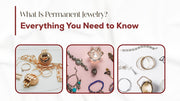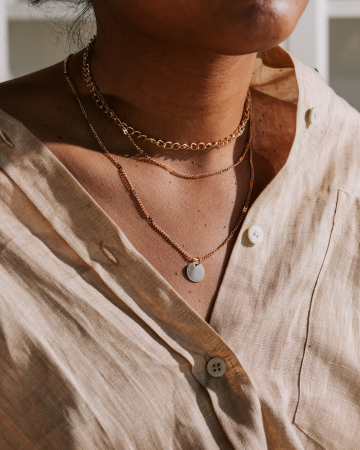Ever lost an earring or broken a favorite necklace clasp? Permanent jewelry eliminates these frustrations. This growing trend transforms how we wear and think about our accessories, creating pieces that become part of your daily life.
What is permanent jewelry made of? How much does permanent jewelry cost, and how long does permanent jewelry last? You'll discover everything about this clasp-free jewelry revolution, the real costs you can expect, and whether it's right for your lifestyle. No fluff—just the practical information you need to make an informed decision about permanent jewelry.

What Is Permanent Jewelry?
Permanent jewelry gets custom-fitted and welded directly onto your body without clasps or closures. A jeweler uses a small welding tool to connect chain ends while you wear the piece, creating seamless bracelets, necklaces, anklets, or rings.
Once applied, you shower with it, sleep in it, and never remove it. Popular options include:
-
Bracelets (most requested)
-
Necklaces
-
Anklets
-
Rings (less common due to finger size changes)
This method produces sleek lines with no exposed fasteners. While earlier civilizations had comparable customs, today's permanent jewelry emphasizes individuality and ease, differing from the ceremonial meaning of the past.
Also Read: What Are Jump Rings? How to Use Them in Jewelry Making
Why Choose Permanent Jewelry?
Emotional Connection
People choose permanent jewelry to mark meaningful moments:
-
Friendship bonds - Matching pieces between close friends
-
Relationship milestones - Couples celebrating anniversaries or commitments
-
Personal achievements - Graduating, career changes, or overcoming challenges
-
Family connections - Mothers and daughters, siblings, or multi-generational experiences
Style Benefits
Fashion-wise, permanent jewelry offers distinct advantages:
-
Clean aesthetic - No visible clasps interrupt the design
-
Layering foundation - Permanent pieces anchor other jewelry
-
Effortless coordination - Your jewelry always matches your intended look
-
Minimalist appeal - Streamlined appearance fits modern style preferences
Practical Advantages
Daily life becomes simpler:
-
Never lose jewelry - Can't fall off or get forgotten
-
Streamlined routines - One less decision when getting ready
-
Travel ease - No jewelry cases or security concerns
-
Active lifestyle friendly - Perfect for gym-goers or hands-on workers

Materials Used in Permanent Jewelry
Your material choice affects appearance, durability, and price. Here's what permanent jewelry is made of:
Gold Varieties
14k Gold - Most popular choice
-
58.3% pure gold mixed with stronger metals
-
Excellent durability for daily wear
-
Available in yellow, white, and rose gold
-
Best balance of quality and price
18k Gold - Premium option
-
75% pure gold content
-
Softer, more luxurious feel
-
Higher cost but exceptional quality
-
May show wear faster due to softness
10k Gold - Budget-friendly
-
41.7% pure gold
-
More durable but less valuable
-
Good starter option for first-time buyers
Silver and Alternatives
Sterling Silver - Classic choice
-
92.5% pure silver
-
Requires regular maintenance
-
Affordable way to try permanent jewelry
Gold-Filled - Middle ground option
-
Thick gold layer bonded to base metal
-
More affordable than solid gold
-
Good durability for permanent wear
Choosing Your Material
Consider these factors:
-
Skin sensitivity - Some metals cause reactions
-
Activity level - Active lifestyles need durable options
-
Budget - Material dramatically affects final cost
-
Color preference - Gold tones vs. silver appearance

Permanent Jewelry Costs
How much does permanent jewelry cost? Prices vary based on material, length, and location.
Price Ranges
Permanent Bracelets:
-
Sterling silver: $50-$150
-
14k gold-filled: $100-$250
-
14k solid gold: $200-$500
-
18k gold: $300-$800
Permanent Necklaces:
-
Sterling silver: $75-$200
-
14k gold-filled: $150-$350
-
14k solid gold: $250-$600
-
18k gold: $400-$1,000
Permanent Anklets:
-
Sterling silver: $60-$175
-
14k gold-filled: $125-$300
-
14k solid gold: $225-$550
Cost Factors
Material Quality
-
Metal type and purity
-
Chain thickness and style
-
Special finishes or textures
Size and Style
-
Longer chains need more material
-
Complex chain patterns cost more
-
Custom sizing adds to base price
Location Variables
-
Urban areas typically charge more
-
Experienced jewelers command premium rates
-
Studio overhead affects pricing
Additional Expenses
Budget for these potential costs:
-
Removal fees if needed later
-
Repair costs for broken chains
-
Replacement costs after damage
-
Travel expenses for specific jewelers
How Long Does Permanent Jewelry Last
How long does permanent jewelry last? Durability depends on material choice and care practices.
Lifespan by Material
Gold Options:
-
14k gold: 10-20 years with proper care
-
18k gold: 8-15 years (softer, wears faster)
-
10k gold: 15-25 years (more durable alloy)
Silver Options:
-
Sterling silver: 5-10 years with maintenance
-
Needs more frequent cleaning
-
3-7 years depending on gold layer thickness
-
Eventually shows base metal
Durability Factors
Daily Activities
-
Manual labor stresses chains
-
Chemical exposure (cleaning products, pools)
-
Exercise and sports impact
Body Chemistry
-
Individual skin chemistry affects tarnishing
-
Medications influence metal reactions
-
Hormonal changes impact appearance
Environmental Conditions
-
Climate and humidity
-
Saltwater or chlorine exposure
-
Urban pollution effects
Quality Elements
-
Chain thickness affects longevity
-
Welding quality determines weak points
-
Chain style impacts durability
Warning Signs
Watch for these indicators:
-
Visible tarnishing or color changes
-
Weak spots or kinks developing
-
Skin irritation or green marks
-
Loose welding points
Getting Permanent Jewelry: The Process
Wondering how to do permanent jewelry? Here's what actually happens during your appointment.
Before Your Visit
Preparation Steps
-
Research experienced jewelers in your area
-
Choose metal type and style preferences
-
Set your budget and identify any allergies
-
Schedule a consultation for questions
What to Bring
-
Comfortable clothing allowing access to application area
-
Style inspiration photos
-
List of questions about maintenance
During Your Appointment
Consultation
-
Discuss goals and preferences
-
Review material options and pricing
-
Learn about jeweler's experience and methods
-
Understand policies on repairs and adjustments
Fitting
-
Jeweler measures application area
-
Try different chain lengths and styles
-
Make final adjustments for perfect fit
-
Confirm design and final pricing
Welding
-
Chain gets placed on your body
-
Small handheld welding tool connects ends
-
Process takes 5-10 minutes
-
Most people experience minimal discomfort
Safety and Comfort
Physical Sensation
-
Brief warm feeling at welding point
-
No pain when done properly
-
Slight pressure from tools
-
Generally comfortable experience
Safety Measures
-
Experienced jewelers use proper equipment
-
Protective barriers shield skin
-
Quality welding tools ensure clean connections
-
Sterile environment and clean instruments
Post-Application
Immediate Care
-
Jewelry ready for immediate wear
-
No special care first 24 hours
-
Avoid harsh chemicals first week
-
Follow jeweler's specific aftercare instructions
Cleaning and Maintaining Permanent Jewelry
Proper maintenance keeps your permanent jewelry beautiful and extends its lifespan. Here's how to clean permanent jewelry effectively.
Daily Care
Simple Routine
-
Rinse with warm water during showers
-
Use mild, unscented soap when needed
-
Gently pat dry with soft cloth
-
Avoid pulling or harsh scrubbing
Things to Avoid
-
Abrasive cleaners or scrubbers
-
Bleach or harsh chemicals
-
Excessive pulling or tugging
-
Rough towels or materials
Weekly Cleaning
Gold Pieces
-
Mix warm water with mild dish soap
-
Soak 10-15 minutes
-
Use soft toothbrush for stubborn spots
-
Rinse thoroughly and dry completely
Silver Pieces
-
Use silver polishing cloth weekly
-
For tarnish: make baking soda paste with water
-
Apply gently, rinse, and dry thoroughly
-
Professional cleaning every few months
Professional Services
When to Seek Help
-
Significant tarnishing or discoloration
-
Visible wear or weak spots
-
Skin irritation or reactions
-
Annual inspections for valuable pieces
Professional Options
-
Deep cleaning and polishing
-
Wear and damage inspection
-
Minor repairs when needed
-
Ongoing care recommendations
Cleaning Supplies
Safe Options:
-
Mild dish soap
-
Jewelry-specific cleaners
-
Soft-bristled toothbrushes
-
Microfiber cloths
Avoid These:
-
Harsh chemicals or bleach
-
Abrasive cleaners
-
Ultrasonic cleaners (unless approved)
-
Ammonia-containing products

Ready to Try Permanent Jewelry?
Permanent jewelry offers a unique way to express personal style while enjoying convenience and meaning. Whether you're attracted to the symbolism, seamless look, or practical benefits, understanding the process helps you decide if it fits your lifestyle.
Consider your daily activities, budget, and long-term plans before committing. Research local jewelers, understand costs, and book a consultation to discuss your specific needs and ask remaining questions.
Your perfect permanent piece might be just one appointment away.
Frequently Asked Questions
1. Can permanent jewelry be removed?
Yes, professional jewelers can remove permanent jewelry using specialized tools. However, removal typically requires cutting the chain, so the piece usually can't be reworn without repair.
2. What happens when permanent jewelry breaks?
Contact your jeweler immediately if your piece breaks. Many offer repair services, though costs vary by damage and material. Some provide warranties covering manufacturing defects.
3. Can I shower and swim with permanent jewelry?
Yes, permanent jewelry handles daily showers. However, frequent chlorine, saltwater, or harsh chemical exposure may accelerate wear and require more cleaning.
4. Will permanent jewelry trigger metal detectors?
Permanent jewelry typically doesn't set off standard metal detectors due to minimal metal content. Airport security may ask about it during screening.
5. How should permanent jewelry fit?
Permanent jewelry should feel snug but comfortable with room for normal swelling. Most jewelers recommend being able to slide one finger under a permanent bracelet.
6. What if my permanent jewelry gets caught?
If permanent jewelry snags, don't pull forcefully. Work it free gently, and contact your jeweler for inspection if damage occurs.
7. What's the difference between permanent and regular jewelry?
Permanent jewelry lacks traditional clasps and gets welded directly onto your body. Regular jewelry has clasps, hooks, or other removable mechanisms.


